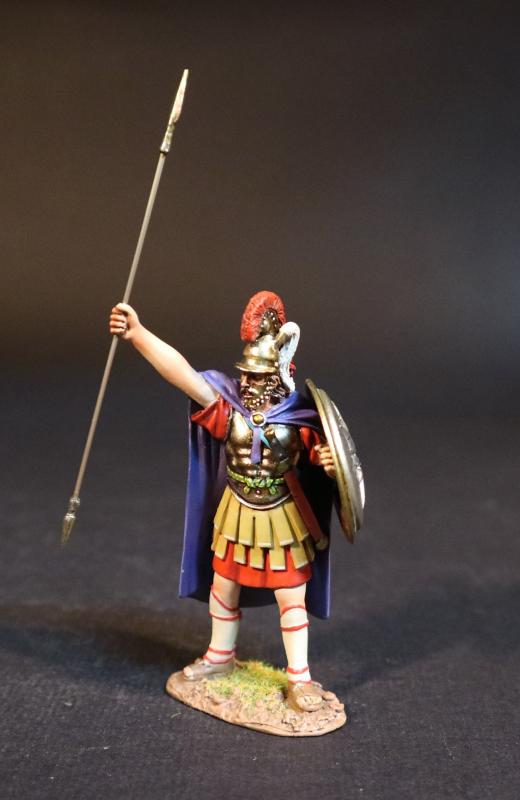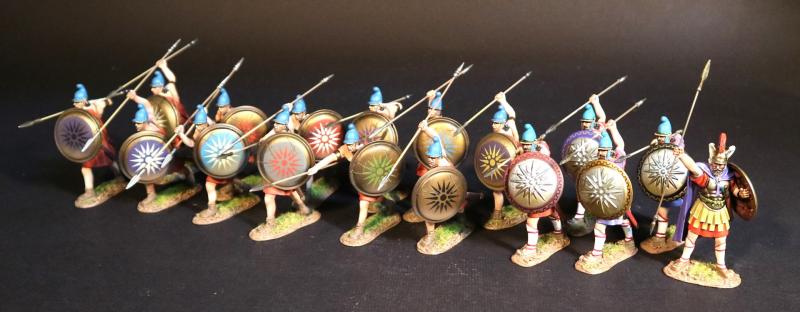Nicanor, Son of Parmnio, Macedonian Argyraspides (Silver Shields), The Macedonians, Armies and Enemies of Ancient Greece and Macedonia--single figure with spear raised to the sky
$54.00
Item Number: MACSS-01
Nicanor, Son of Parmnio, Macedonian Argyraspides (Silver Shields), The Macedonians, Armies and Enemies of Ancient Greece and Macedonia--single figure with spear raised to the sky
ARMIES AND ENEMIES OF GREECE AND MACEDONIA
THE MACEDONIAN ARMY
THE ARGYRASPIDES (SILVER SHIELDS)
The Argyraspides were elite Macedonian soldiers who carried silver plated shields. The original unit were Hypaspists serving in the army of Alexander the Great. They were a division of the Macedonian army, and were picked men commanded by Nicanort, the son of Parmenio, as well as Seleucus, and were held in high honour by Alexander. They were hypaspists, having changed their name to the Argyraspides whilst in India under Alexander.
Nicanor, was a distinguished officer in the service of Alexander the Great.
He is first mentioned at the passage of the Danube river, in the expedition of Alexander against the Getae, 335, when he led the phalanx. During the expedition into Asia, he appears to have held the chief command of the Hypaspists. It is mentioned of him holding this post in the three great battles of the Granicus, Issus, and of Gaugamela. He was to accompany Alexander during the rapid march in pursuit of the king Darius III Codmannus in 330. This was probably his last service, as he was to die of disease shortly afterwards, during the advance into Bactria.
His death at this time was considered a fortunate event, as it prevented him from participating either in the designs or the fate of his brother Philotas.
The Macedonian phalanx was an infantry formation developed by Philip II and used by his son Alexander the Great to conquer the Achaemenid Empire and defeat armies of other kingdoms. Phalanxes remained dominant on battlefields throughout the Hellenistic period, until they were ultimately displaced by the Roman Legions.
In 359 BCE, the Macedonian army led by the king Perdiccas III, was decidedly defeated by the Illyrians. Perdiccas’ brother Philip II had been a hostage in Thebes for much of his youth, and what he had learned influenced his restructuring of the Macedonian infantry. Philip’s military reforms were a new approach to the current hoplite warfare, which focused on their shield and thrusting spear. Philip’s new focus was on a new weapon, the Sarissa. He called the soldiers in the phalanx Pezhetairoi, meaning “foot companions”.
Each phalangite carried as his primary weapon a Sarissa, a double pointed pike over 18 foot in length. The Sarissae were carried in two pieces before a battle and then slid together when they were to be used. At close range such weapons were of little use, but an intact phalanx could easily keep its enemies at a distance. The weapons of the first few rows of men all projected beyond the front of the formation, so that there were more spear points than available targets at any given time. Men in rows behind the initial rows angled their sarissae at angles in an attempt to ward off arrows or other projectiles.
There was a secondary weapon called a xiphos, which was a short sword. They also had a smaller and flatter shield than that of the Greek Hoplon. The shield was worn hung around the neck so as to free up both hands to wield the sarissa.
The Phalanx consisted of several blocks of men, called syntagmata. There were 16 of these with 16 men in each Syntagmata. Each block was commanded by a syntagmatarchy, who together with his subordinate officers would form the first row of each block.
Neither Philip or Alexander actually used the phalanx as their arm of choice, but instead used it to hold the enemy in place while their heavy cavalry broke through the enemy ranks.
The Macedonian cavalry fought in a wedge formation and was almost always stationed on the far right.
The hypaspists an elite infantry unit were stationed on the immediate right of the phalanx wielding hoplite sized shields and spears.
The left flank was generally covered by allied cavalry usually Thessalians, which fought in a rhomboid formation and served mainly in a defensive role.
Released in AUGUST 2025.

